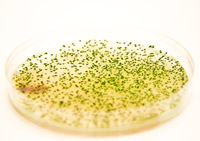Converting Carbon Dioxide into Liquid Fuel with Bacteria
 More and more people are becoming aware of the harmful effects of greenhouse gases. Common people and scientists both are gearing up to reduce carbon footprints. Now more investments are available for research in alternative energy. Researchers from the UCLA Henry Samueli School of Engineering and Applied Science have genetically been working on a cyanobacterium. Their research paper was published in the Dec. 9 print edition of the journal Nature Biotechnology. They successfully modified a cyanobacterium to consume carbon dioxide and generate the liquid fuel isobutanol. This isobutanol can prove to be of great potential as a gasoline alternative. The whole process happens with the help of sunlight through photosynthesis.
More and more people are becoming aware of the harmful effects of greenhouse gases. Common people and scientists both are gearing up to reduce carbon footprints. Now more investments are available for research in alternative energy. Researchers from the UCLA Henry Samueli School of Engineering and Applied Science have genetically been working on a cyanobacterium. Their research paper was published in the Dec. 9 print edition of the journal Nature Biotechnology. They successfully modified a cyanobacterium to consume carbon dioxide and generate the liquid fuel isobutanol. This isobutanol can prove to be of great potential as a gasoline alternative. The whole process happens with the help of sunlight through photosynthesis. James C. Liao is the team leader of this project. He is also the Chancellor’s Professor of Chemical and Biomolecular Engineering at UCLA and associate director of the UCLA-Department of Energy Institute for Genomics and Proteomics. He voiced his opinions about the biofuel, “This new approach avoids the need for biomass deconstruction, either in the case of cellulosic biomass or algal biomass, which is a major economic barrier for biofuel production. Therefore, this is potentially much more efficient and less expensive than the current approach.”
This new method carries several advantages. If we care to look at this fuel in the long term scenario and want to achieve a cleaner and greener energy economy, this fuel might prove helpful. Its first advantage is, it recycles carbon dioxide, which leads to reducing greenhouse gas emissions. Its second advantage is, it uses solar energy to convert the carbon dioxide into a liquid fuel. This fuel is an improvement over other alternatives to gasoline. Other biofuels are derived from plants or algae and both of these processes need numerous intermediate steps before refinement into usable fuels.
Researchers experimented on the cyanobacterium Synechoccus elongates. They first genetically increased the quantity of the carbon dioxide-fixing enzyme RuBisCO. Then they tied together genes from other microorganisms to engineer a strain. This strain utilizes carbon dioxide and sunlight and produces isobutyraldehyde gas. The low boiling point and high vapor pressure of the gas make it possible to remove this gas from the system. The engineered bacteria can generate isobutanol directly. But researchers are not very enthusiastic about it. They are of the view that it is good to utilize a time tested and relatively cheap chemical catalysis process to convert isobutyraldehyde gas to isobutanol, as well as other useful petroleum-based products.
Researchers think that an apt location for this system would be near a power plant because they emit carbon dioxide. This carbon dioxide can be utilized and converted into liquid fuel.
Liao said, “We are continuing to improve the rate and yield of the production. Other obstacles include the efficiency of light distribution and reduction of bioreactor cost. We are working on solutions to these problems.”
You can return to the main Market News page, or press the Back button on your browser.

